Exploring the Temperate Rain Forests of Olympic National Park
Occupying much of the Olympic Peninsula in northwestern Washington State, Olympic National Park protects a wide variety of ecosystems, from alpine meadows and lakes to rugged coastlines and verdant rain forests.
In fact, Olympic National Park is so diverse that it’s often called “three parks in one.” Its marvelous biodiversity is a main reason why it’s a UNESCO World Heritage Site and International Biosphere Reserve, two designations that indicate the park’s global importance.
One of the national park’s most popular attractions are its temperate rain forests, which are found on the lower western slopes of the Olympic Mountains.
I’ve explored all four temperate rain forests in Olympic National Park, some more extensively than others, and every time I visit them, they blow me away with their incredible lushness, marvelous shades of green, and perhaps above all, their silence.
Below, you’ll find an overview of Olympic National Park’s four rain forests, all of which are situated in low-elevation valleys created by rivers flowing down from the mountains above.
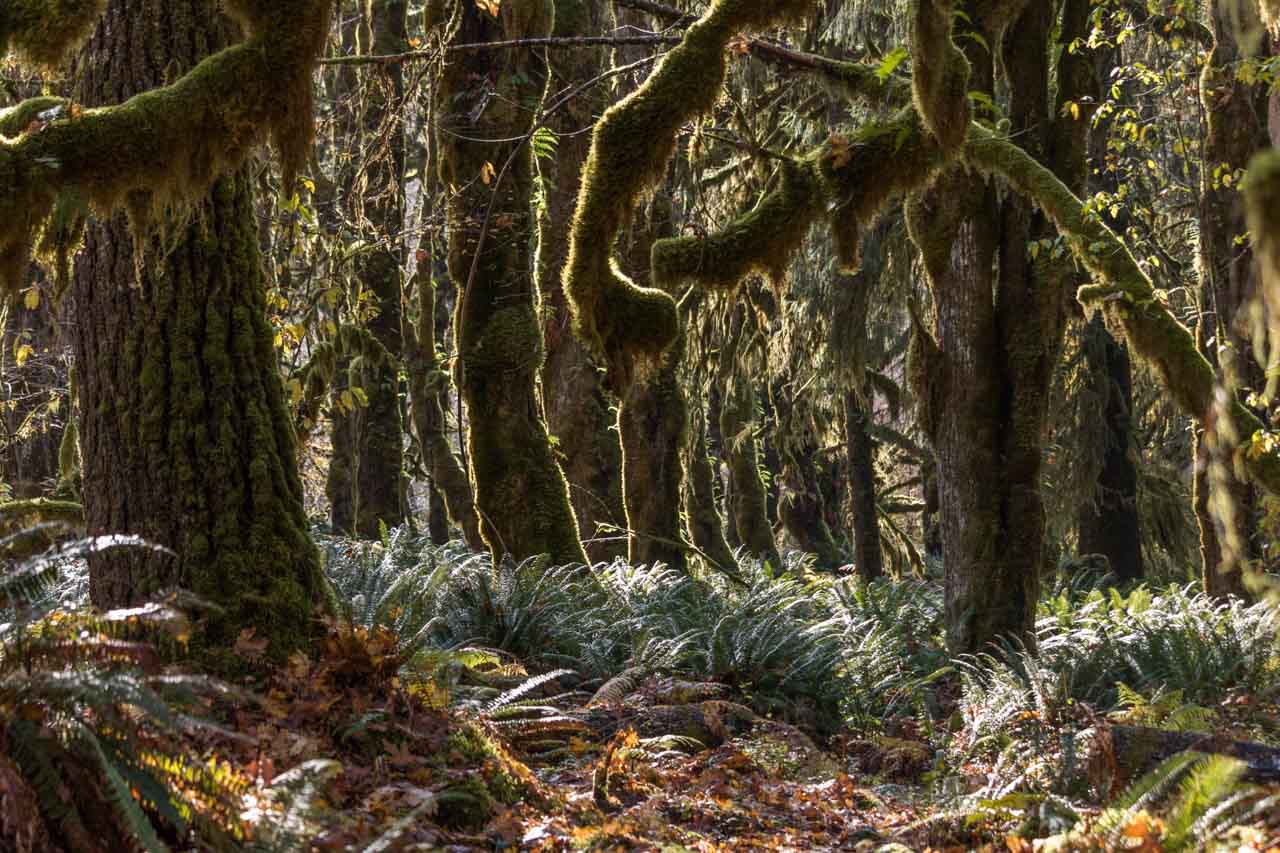
Immerse Yourself in the Lushness and Quietness of the Olympic National Park Rain Forests
The rain forests of Olympic National Park “are some of the most spectacular examples of primeval temperate rain forest in the lower 48 states,” according to the National Park Service.
Once stretching all the way from southern Oregon to southeast Alaska, only a few intact tracts remain today. And Olympic National Park is easily one of the best and most accessible places to immerse yourself in this lush woodland wonderland, where ferns carpet forest floors, mosses drape tree branches, and lichens cover rocks.
For reference, other places in the world with similar temperate rain forests are southeastern Alaska, southern Australia, New Zealand, and Chile.
If you’re lucky enough to be in an Olympic National Park rain forest by yourself, you can’t help but be overwhelmed by the lack of sounds—unquestionably one of the most memorable experiences in the national park.
Actually, the Hoh Rain Forest in particular is home to—literally—the quietest spot in the United States. It’s called the “One Square Inch of Silence,” designated by Emmy-winning sound recordist Gordon Hempton, who marked the spot on a rock somewhere in the forest.
You can learn more about Hempton’s work, including in the Hoh Rain Forest, by watching the 2010 documentary ‘Soundtracker’ or visiting the website ‘One Square Inch.’
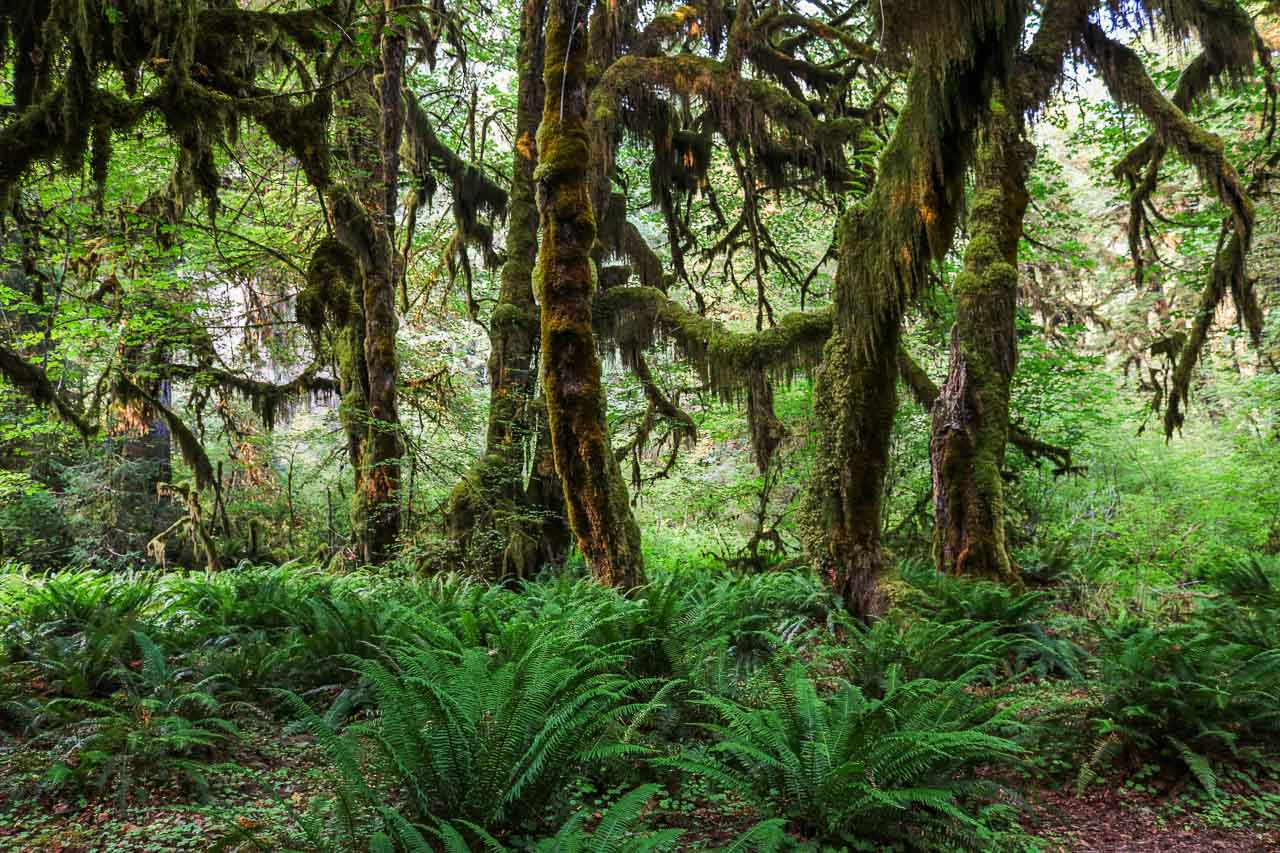
You don’t need to find that exact square inch to enjoy the forest’s deafening silence, though. Just strap on your hiking boots and head out on a hike on one of the many trails.
All of the four rain forests in Olympic National Park have hiking trails and/or unpaved roads, allowing you to really immerse yourself in these exceptionally verdant forests. After a short distance, you’ll start noticing how silent the forest actually is—provided it’s not raining, of course.
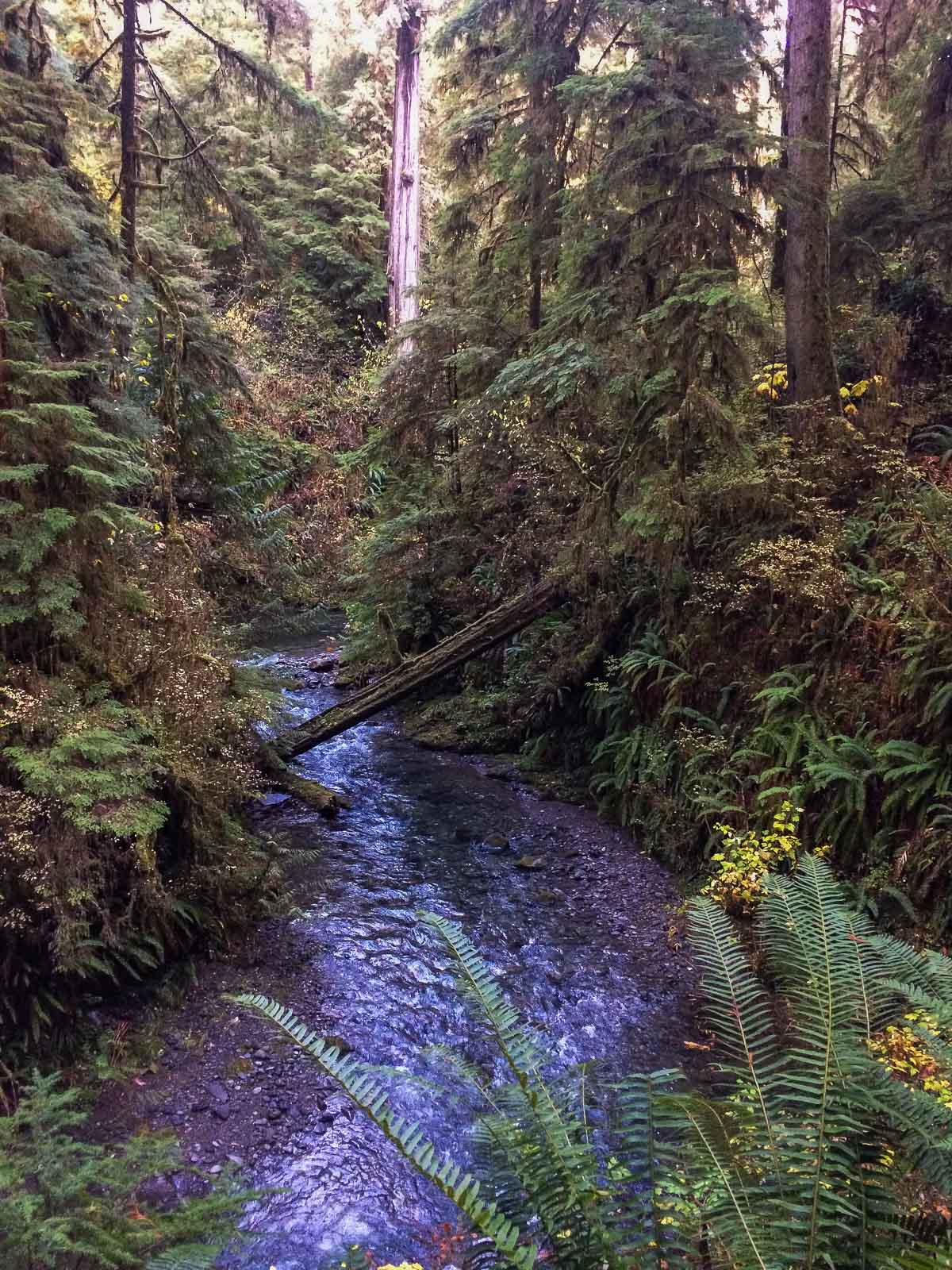
Trees, Plants, and Wildlife of the Rain Forests in Olympic National Park
Located on the western slopes of the Olympic Mountains, these rain forests are inundated by huge amounts of precipitation, ranging from 140 to 167 inches (13+ feet!) per year. It’s one of the wettest areas in the entire country.
When storms roll in from the Pacific Ocean, they hit the Olympic Mountains, which cause them to dump their moisture on the western slopes. This incredible amount of water feeds rivers and streams, trees, shrubs, and epiphytes (which are plants that grow on trees, such as ferns and mosses).
I think it’s worth talking a bit more about the marvelous biodiversity in these rain forests. It’s why they’re so unique in the first place.
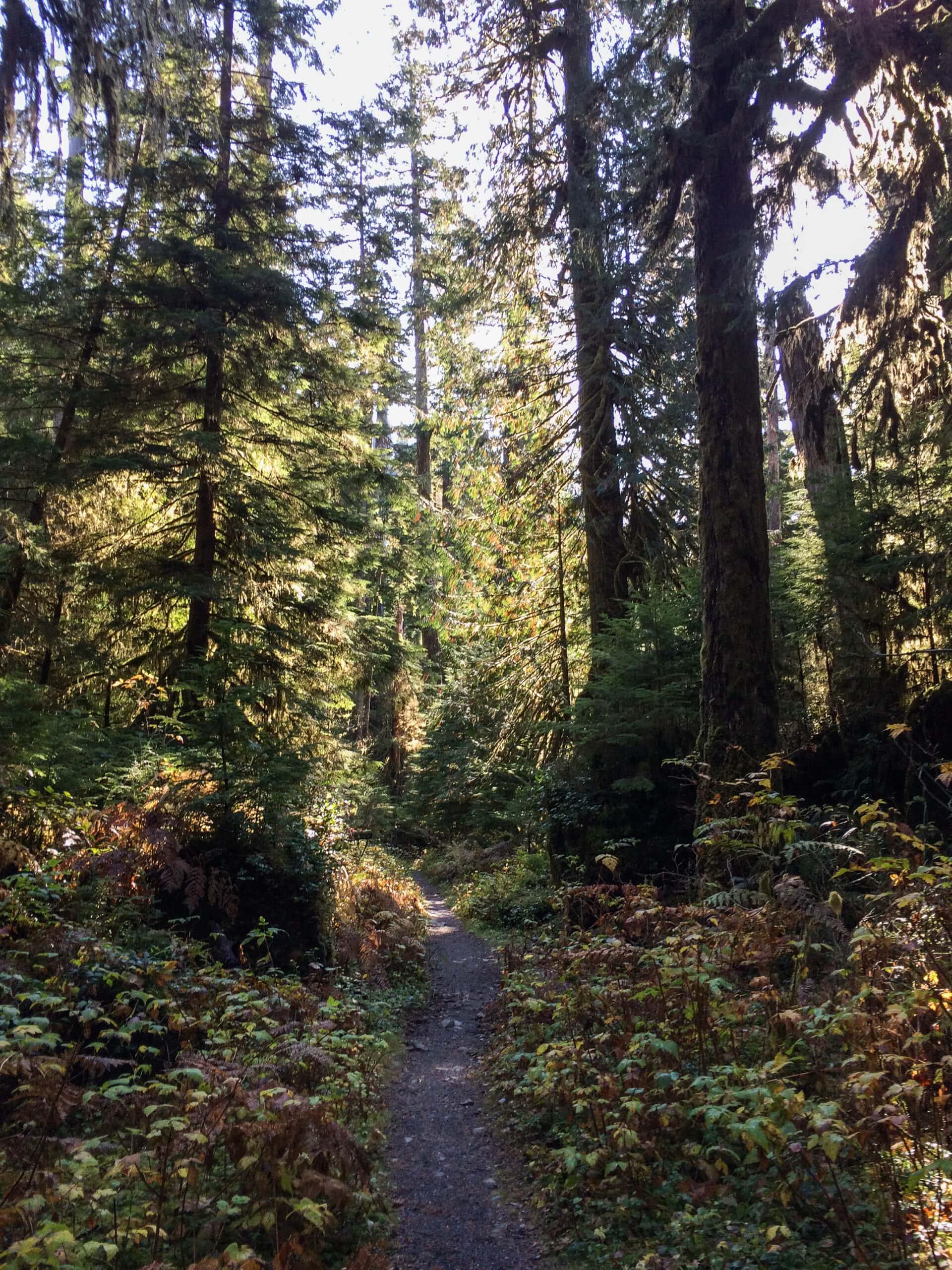
Trees
Some of the trees that live in the Olympic rain forests are among the tallest of their kind in the world, such as Sitka spruce, Douglas-fir, western hemlock, and western redcedar. Many of these trees are hundreds of years old and reach heights of more than 250 feet.
For example, you can find enormous Sitka spruce trees along hiking trails in the Quinault, Queets, and Hoh rain forests. There’s also a giant Douglas fir in the Queets Rain Forest and a towering cedar tree in the Quinault Rain Forest.
Smaller trees you’ll certainly see when exploring the rain forests include red alder, bigleaf maple, and vine maple. These are often the trees that are completely covered in mosses—one of the most iconic sights in the Olympic National Park rain forests.
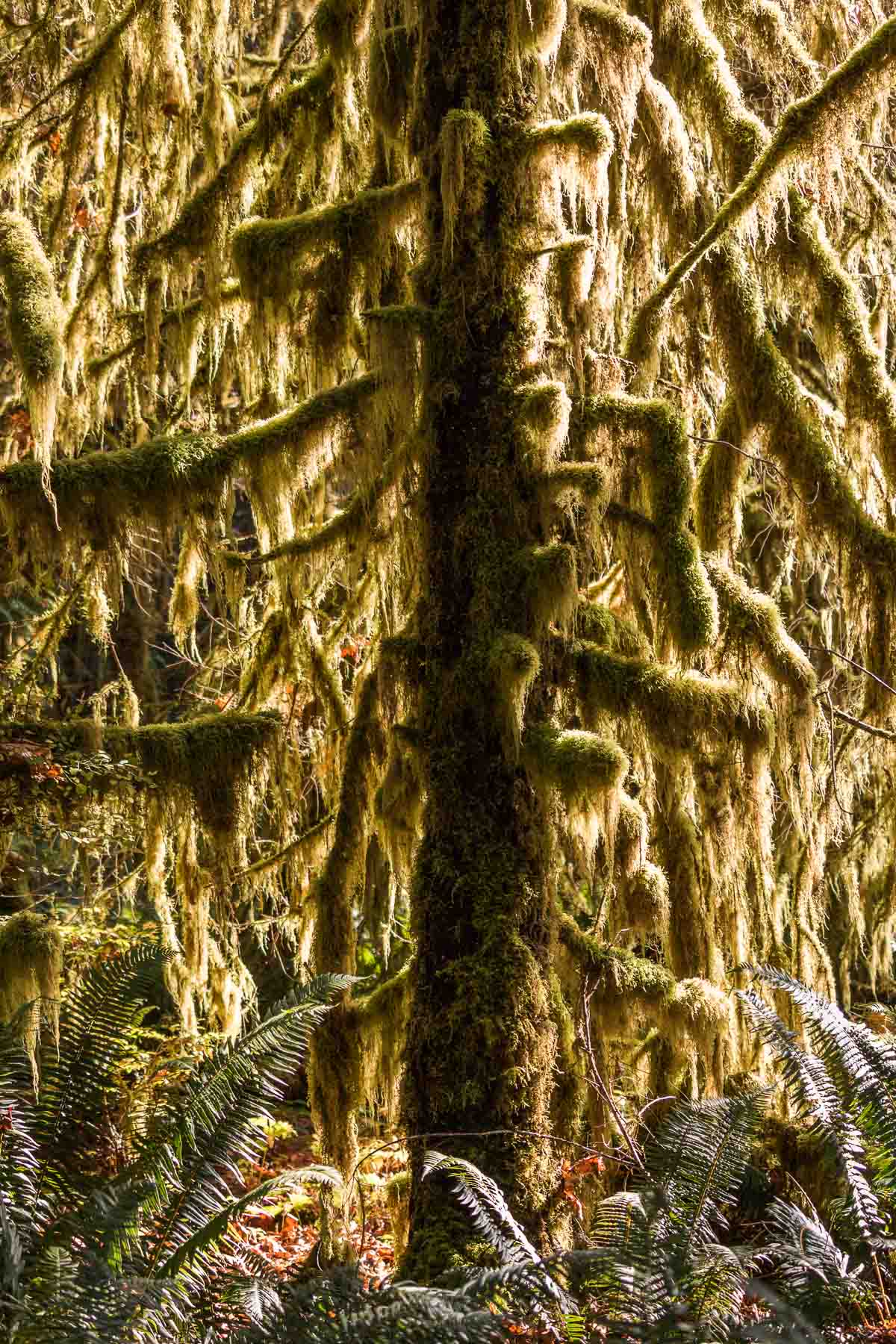
Shrubs and Understory Vegetation
Below the trees, you’ll find shrubs like huckleberries and salmonberries, often concentrated in patches scattered throughout the forest.
Common epiphytes in the rain forest are lungwort, cat-tail moss, Oregon selaginella, and licorice fern, while noticeable understory vegetation includes sword fern, lady fern, stair-step moss, and literally hundreds of other species of lichens, liverworts, and mosses.
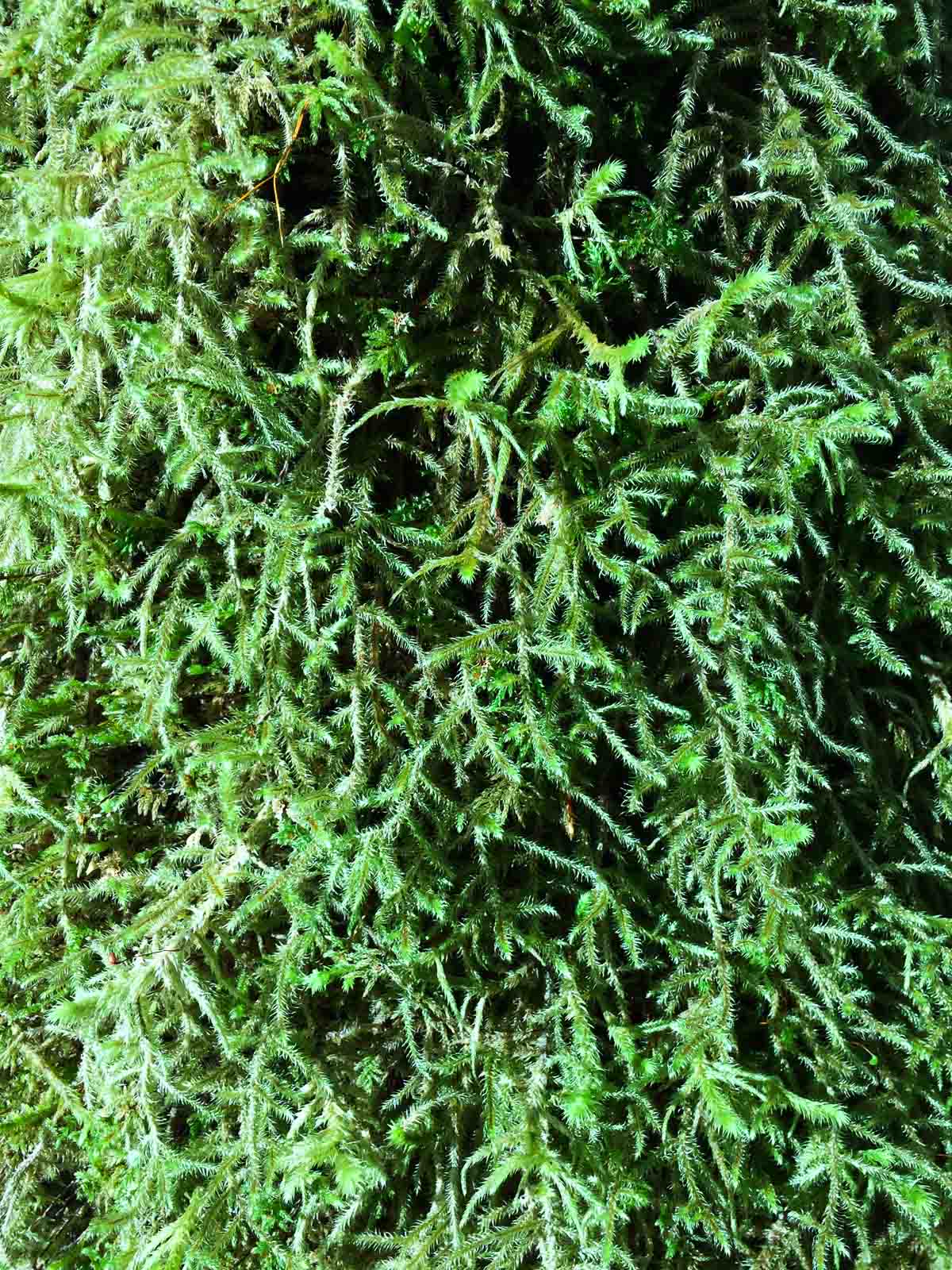
Wildlife
The most iconic animal species in the Olympic National Park rain forests is the Roosevelt elk. In fact, this area is home to the nation’s largest population of this elk subspecies, which is native to the Pacific Northwest.
You can find them in all four rain forests in the park—I’ve personally seen Roosevelt elk in both the Hoh and Quinault rain forests.
Other high-profile animals you might see or encounter in these dense old-growth forests or along riverbanks are spotted owls, eagles, blacktail deer, black bears, bobcats, coyotes, and even cougars.
Smaller wildlife that makes their home in these verdant forests and fast-flowing streams include salamanders, river otters, banana slugs, and Douglas squirrels.
Additionally, the streams and rivers that run through the rain forests are home to steelhead trout, bull trout, and all five Northwest salmon species—chinook, chum, coho, pink, and sockeye.
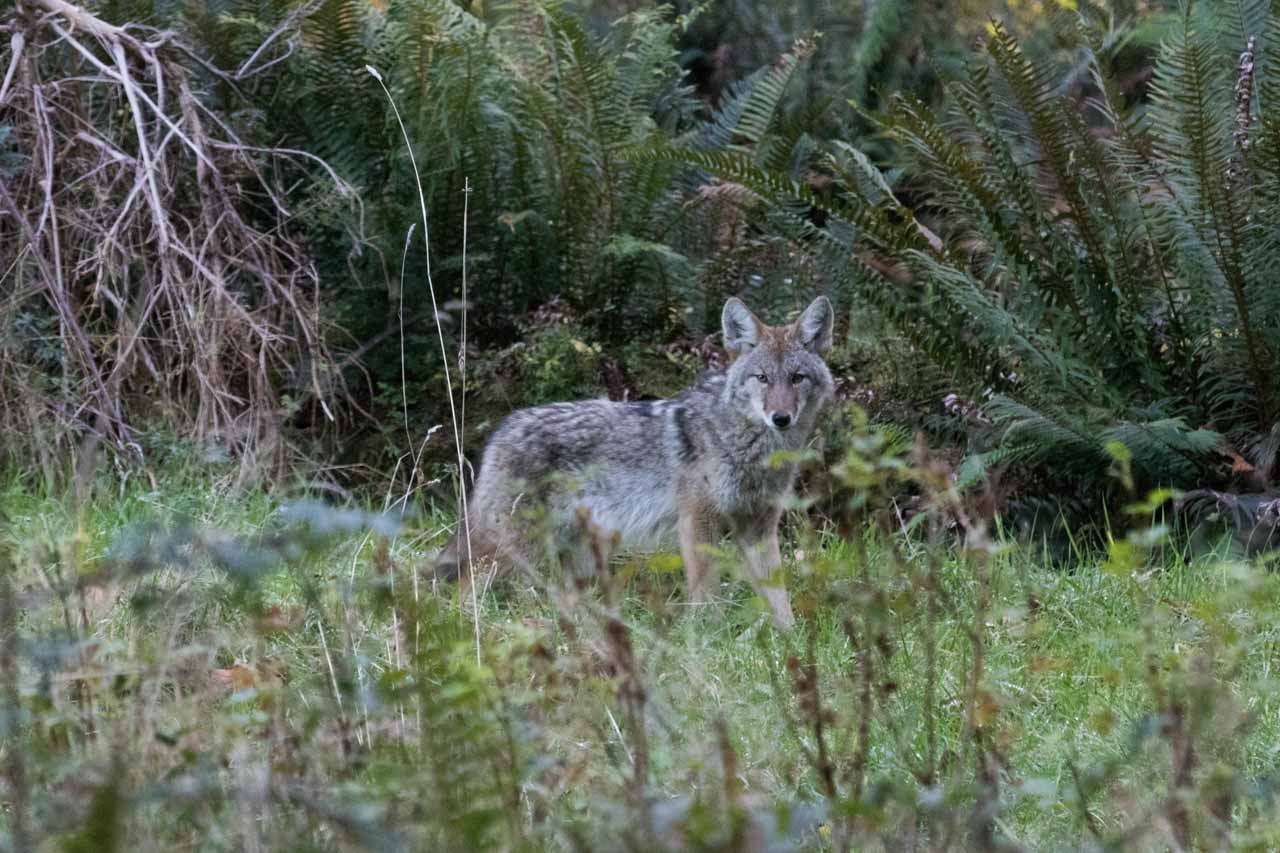
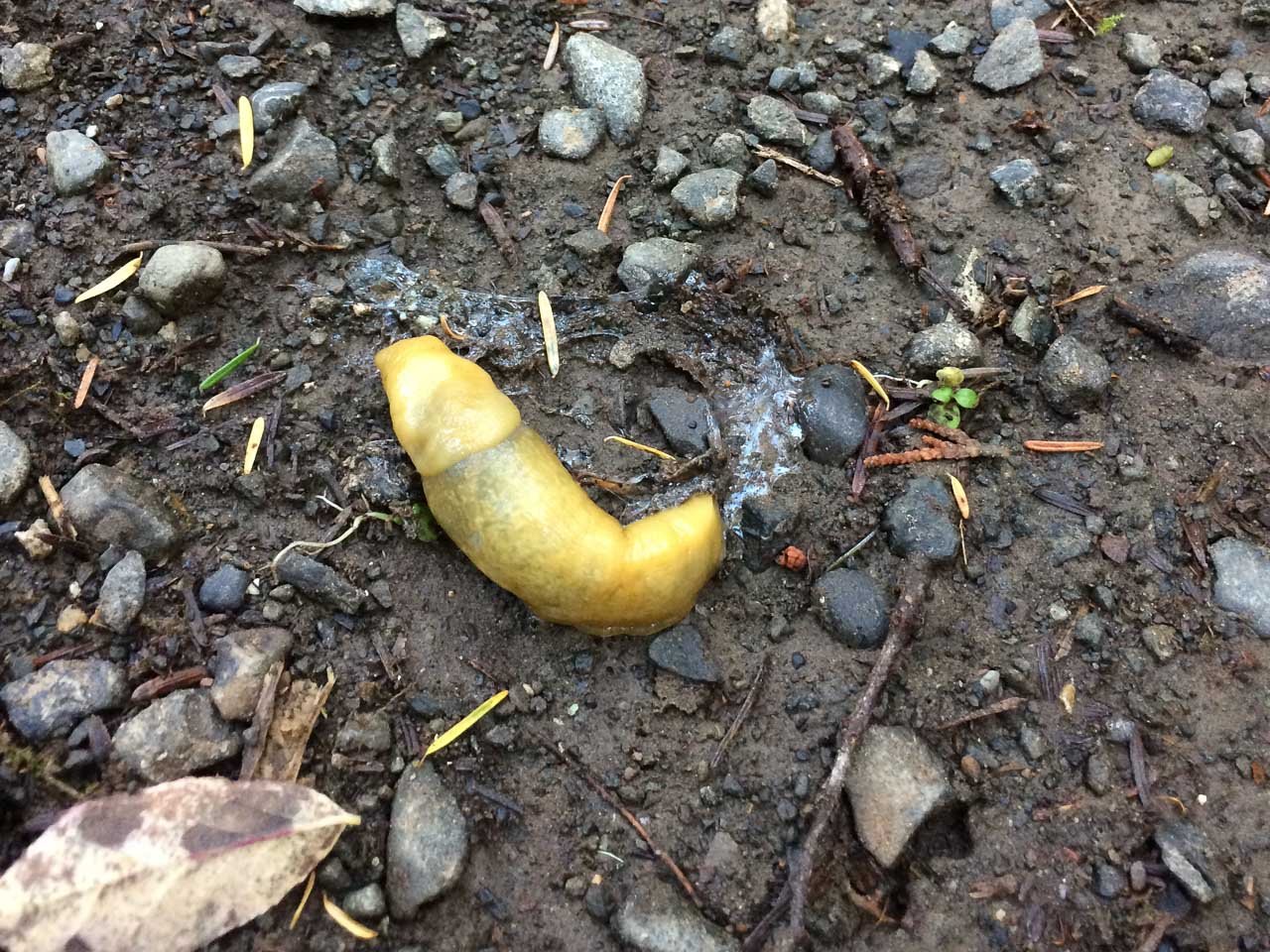
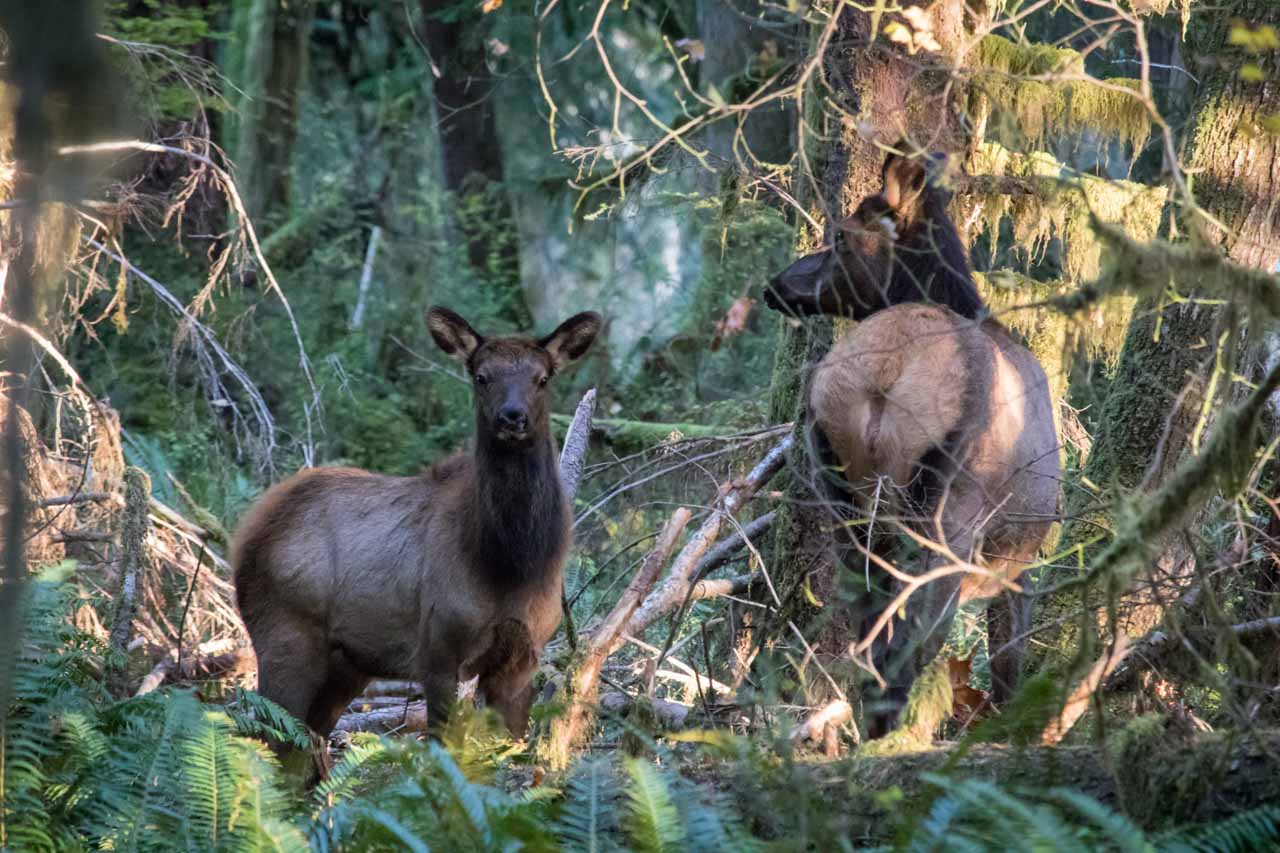
4 Temperate Rain Forest of Olympic National Park
Let’s now take a closer look at the four different rain forests in Olympic National Park. All these forests are in their own river valley and are named after their respective rivers. From south to north, they are:
- Quinault River Valley / Quinault Rain Forest
- Queets River Valley / Queets Rain Forest
- Hoh River Valley / Hoh Rain Forest
- Bogachiel River Valley / Bogachiel Rain Forest
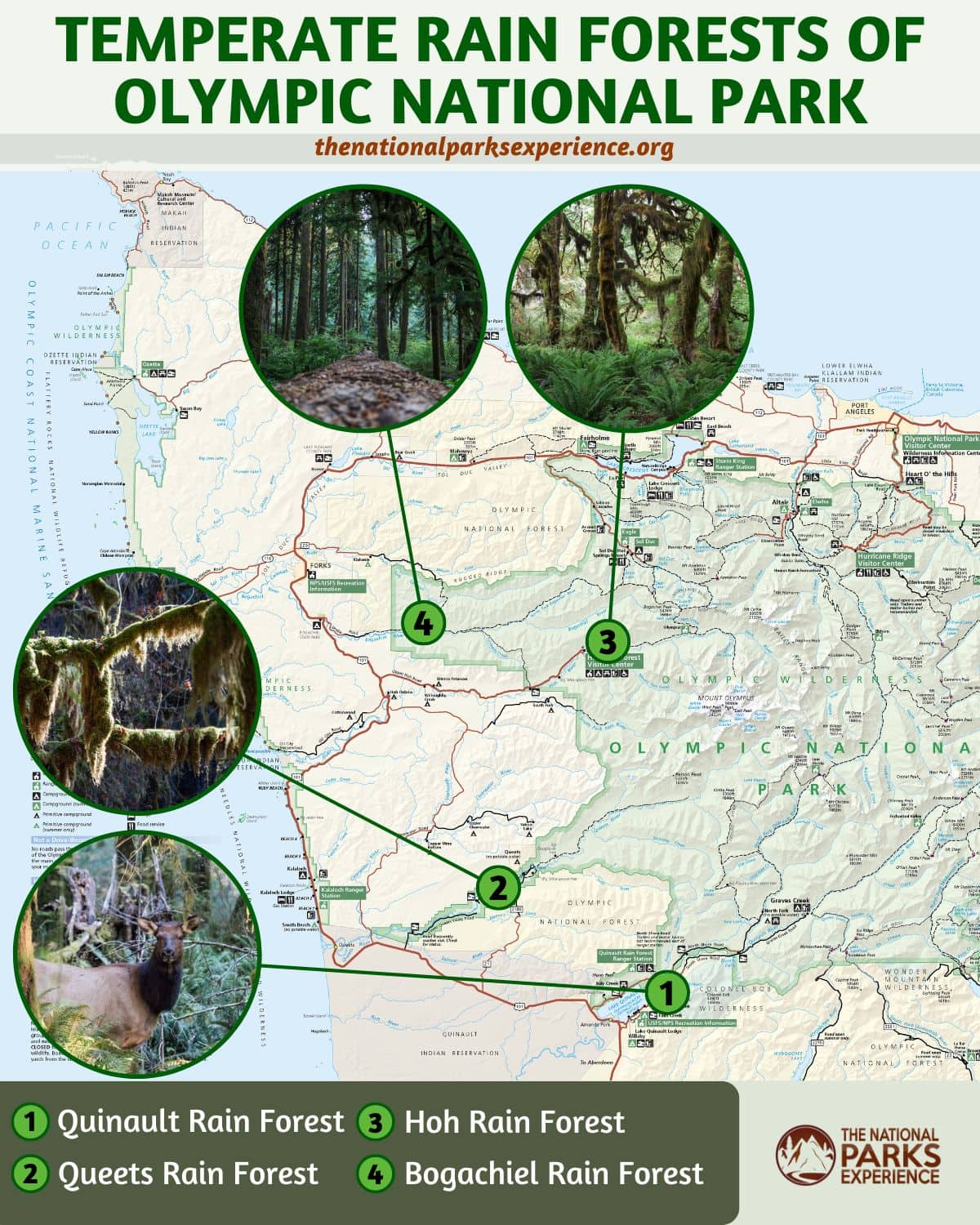
1. Quinault Rain Forest
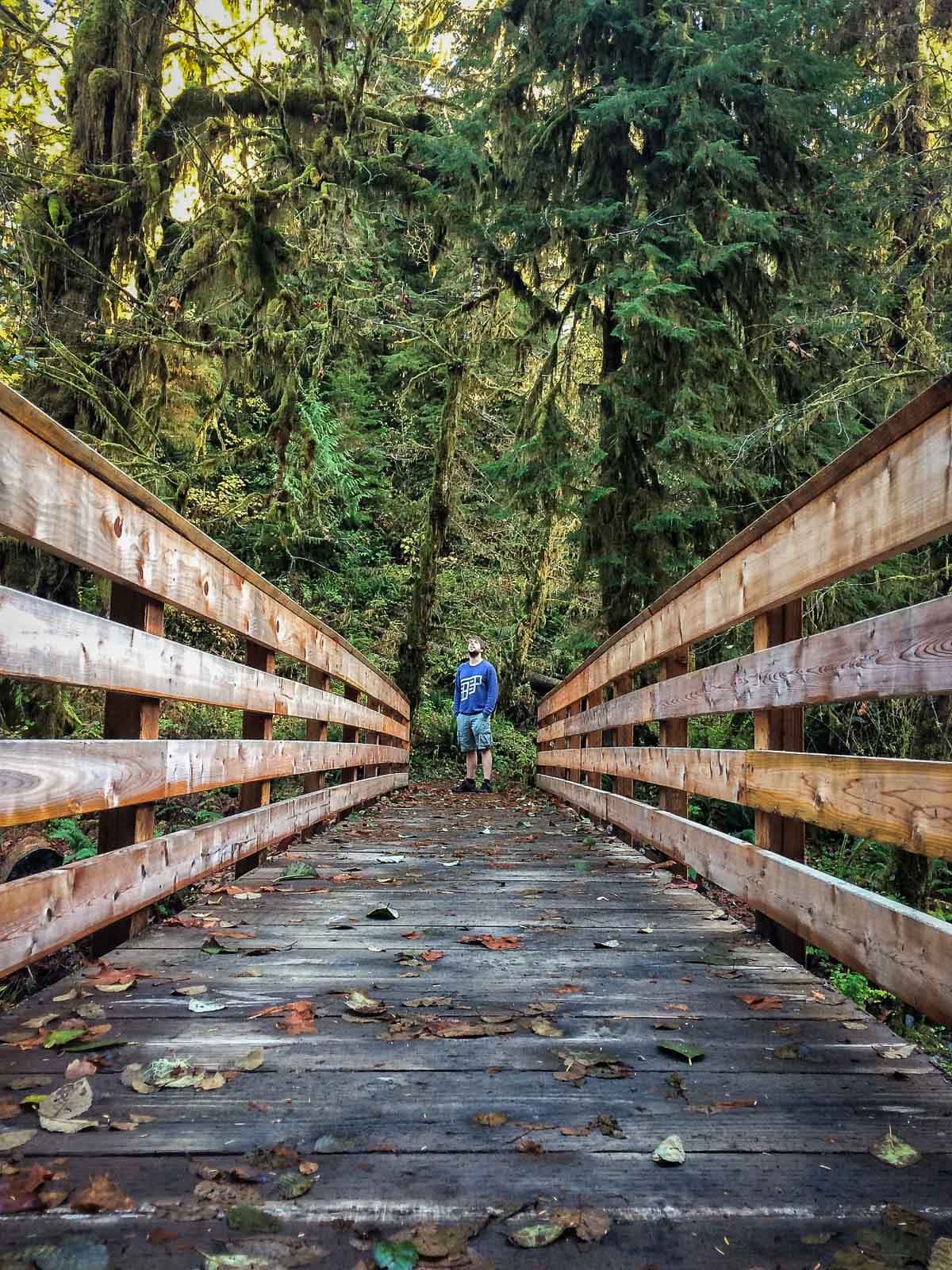
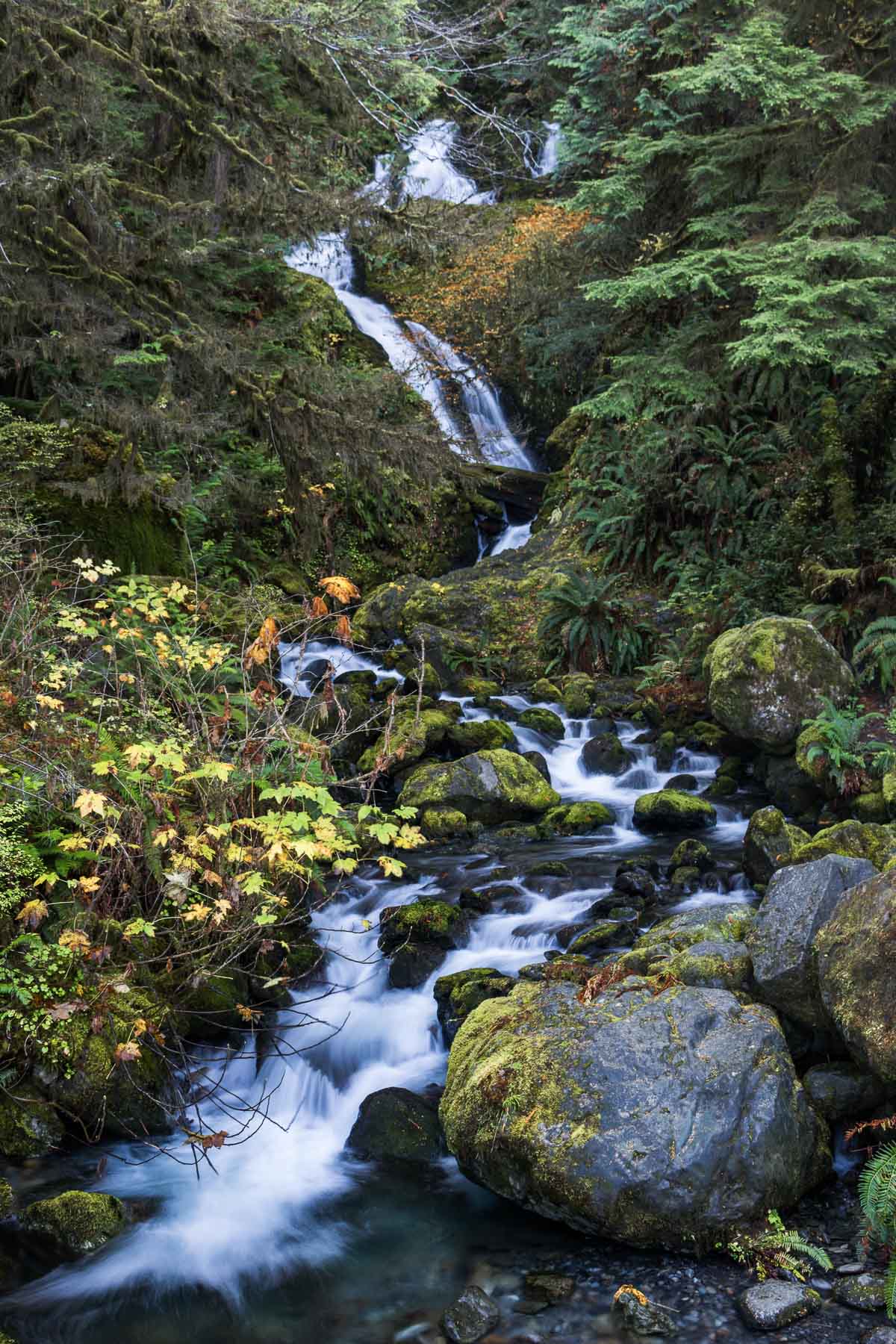
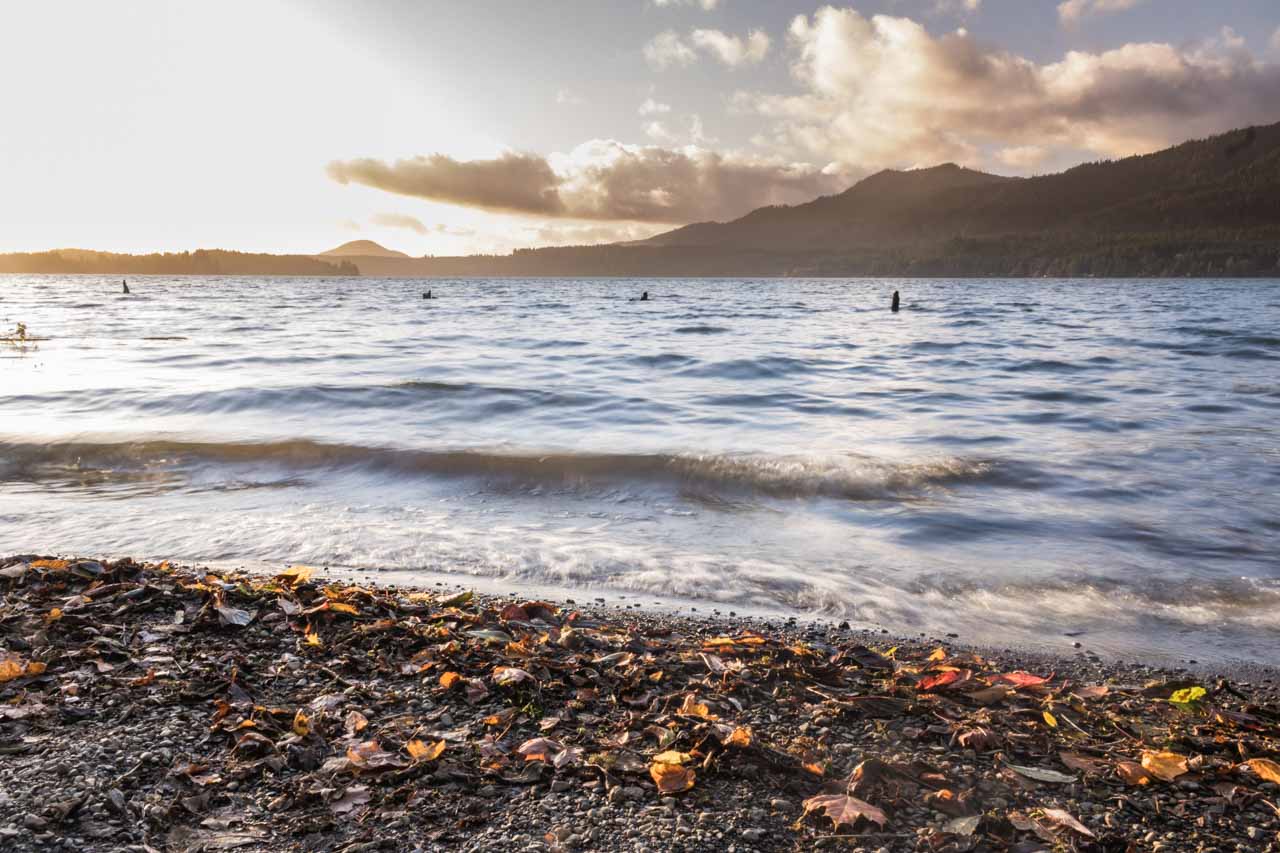
In my opinion, the Quinault Rain Forest is one of the true “hidden gems” of Olympic National Park. Located in the southwestern corner of the park, this amazing area is shared with adjacent Olympic National Forest.
The Quinault area is centered on beautiful Lake Quinault, which lies partially in the national park and partially in the national forest. This is where you’ll find all accommodation options in the Quinault Rain Forest, which include the Rain Forest Resort Village and the historic and iconic Lake Quinault Lodge.
A number of fun hiking trails start in this area, most notably the fantastic Quinault Rain Forest Loop, which is one of my favorite rain forest hikes on the Olympic Peninsula.
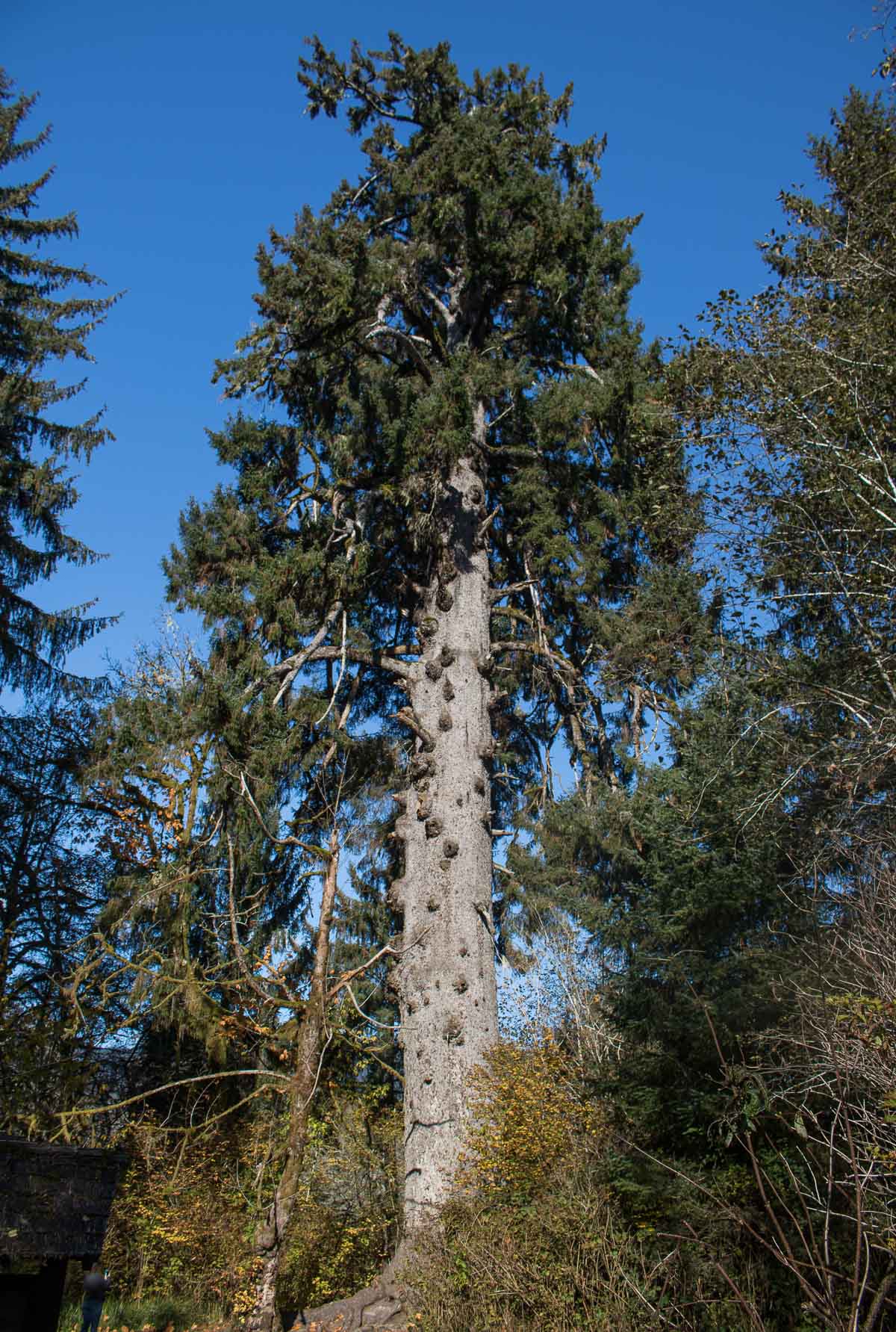
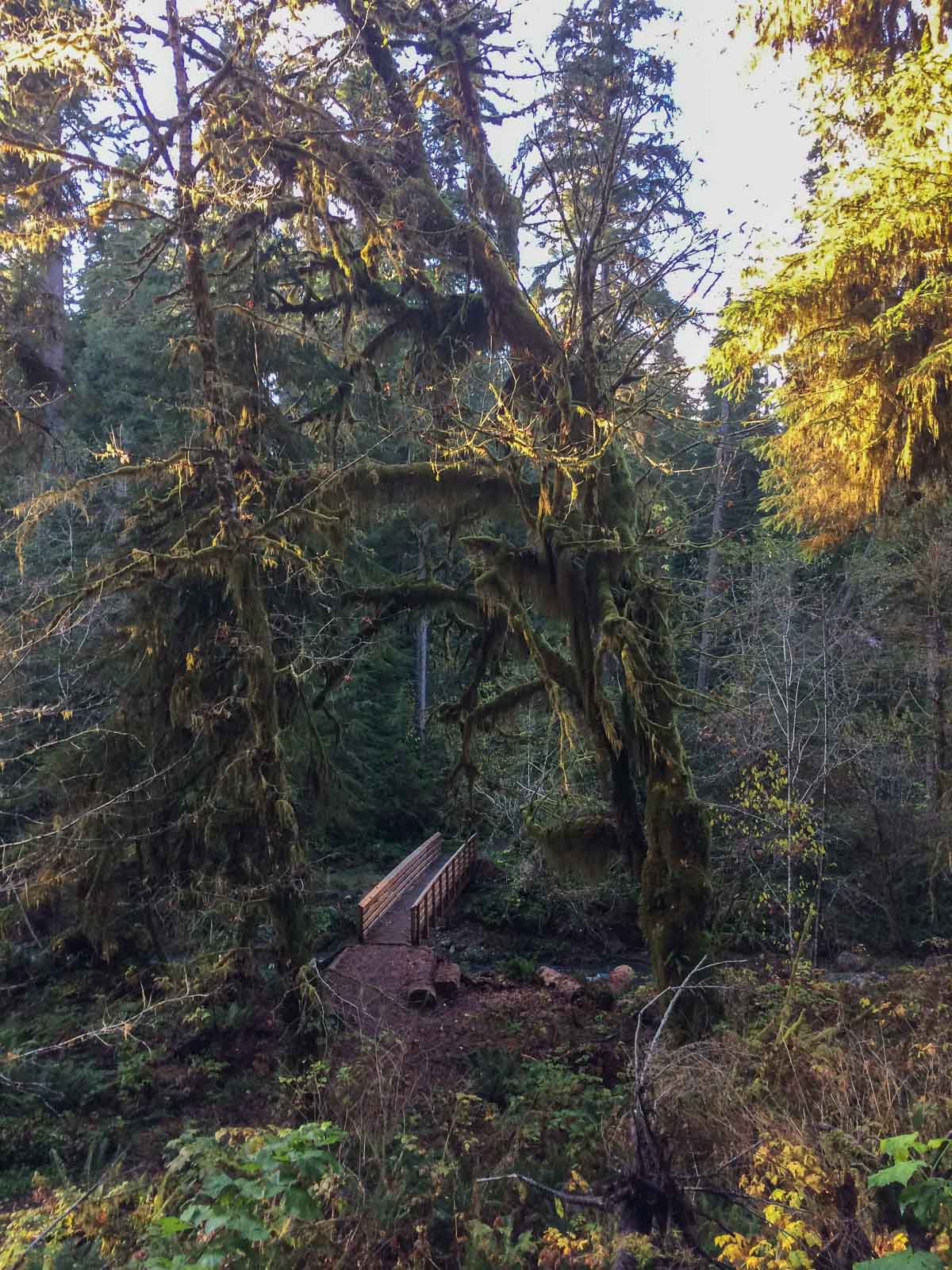
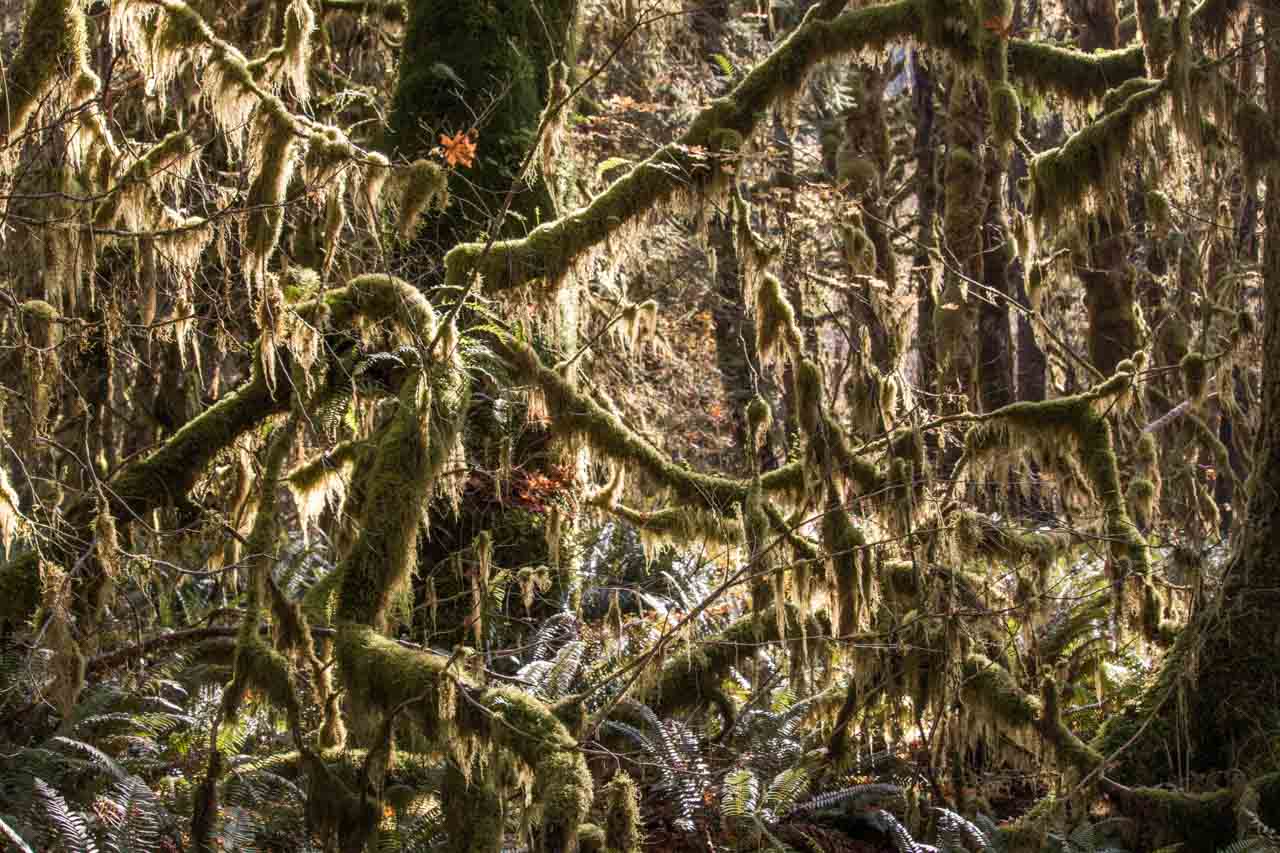
Other attractions are the world’s largest Sitka spruce trees, scenic streams, and a few small waterfalls.
What makes the Quinault Rain Forest unique among the Olympic National Park rain forests is that you can explore a large part of it with your car on South Shore and North Shore roads, which form a wonderful loop drive.
The national park portion of the Quinault Rain Forest, which is along North Shore Road, has features such as a huge cedar tree, the historic Kestner Homestead, a ranger station, a couple of short trails, and excellent Roosevelt elk viewing opportunities.
At the end of Graves Creek Road, which is an extension of the South Shore Road, you’ll find the trailhead of the popular and exceptionally scenic East Fork Quinault River Trail to Enchanted Valley—a popular backpacking trip.
You can find more information about the Quinault Rain Forest in Olympic National Park on the park’s website.
2. Queets Rain Forest
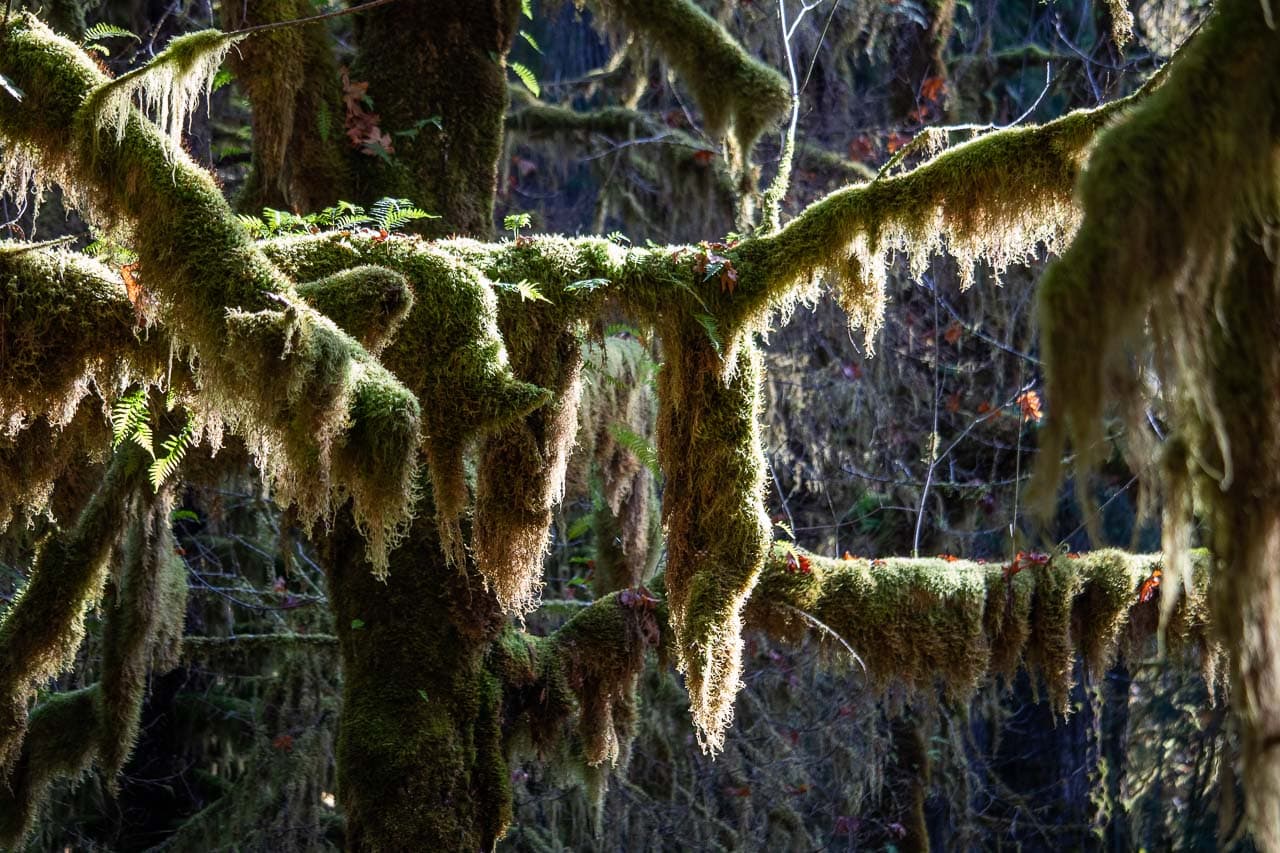
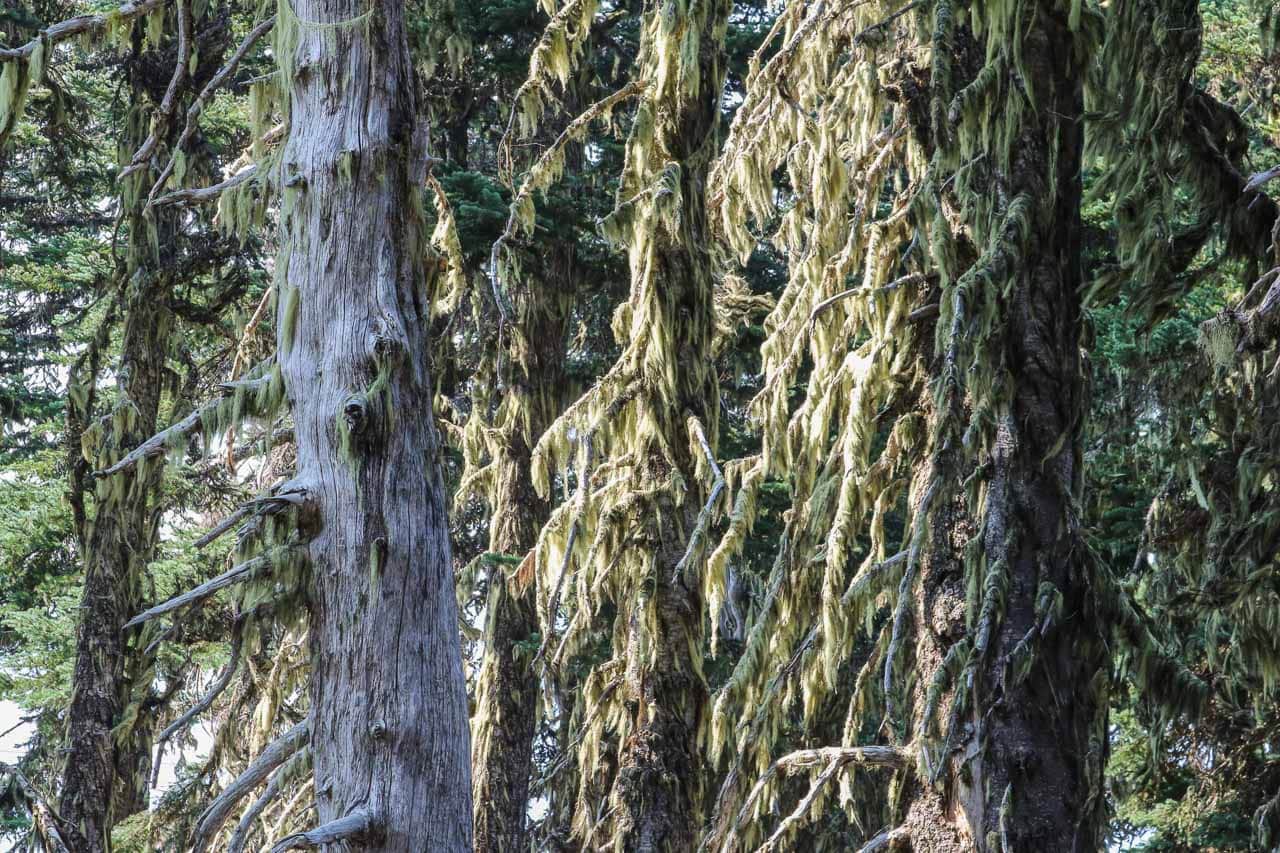
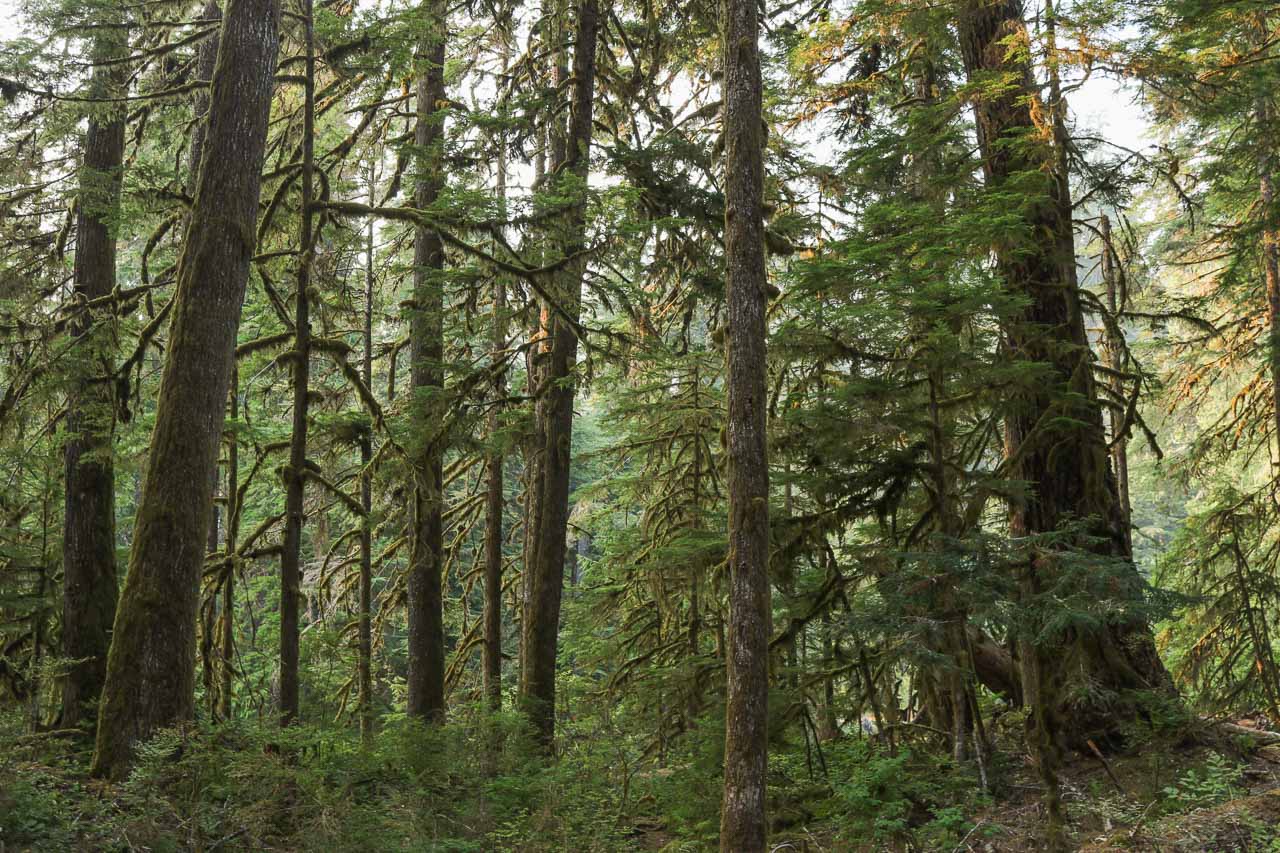
The Queen Rain Forest in Olympic National Park stretches alongside the Queets River almost to the Pacific coast.
This remote area of the park sees few visitors, especially when compared to other parts of the park, making it a great place to immerse yourself in this amazing temperate rain forest.
You can get to the heart of the Queen Rain Forest via two separate roads—the Lower Queets Valley Road and the winding 11-mile Route 21 to the Upper Queets Valley Road. (Both roads were once connected, but got separated from each other by a landslide in 2005.)
Unlike the Quinault and Hoh rain forests, the Queets Rain Forest is quite primitive and has few facilities. The only visitor amenities are a very basic 20-site campground and an unstaffed ranger station.
There are several fun things to do, though, ranging from watching elk grazing underneath maples and salmon spawning in streams, exploring old barns and pastures, and admiring towering Sitka spruce trees.
If you’d like to go hiking at Queets, you can choose from two trails—the easy 2.8-mile Sam’s River Loop and the challenging 16.2-mile Queets River Trail.
Note, though, that the Queets River Trail requires you to ford both the Sam’s River and the Queets River, which can be treacherous. The park advises hikers to wait until the end of summer or the beginning of fall to do this fall, as water levels are at their lowest this time of year. Additionally, this trail is not recommended during or right after stormy weather.
You can find more information about the Queets Rain Forest in Olympic National Park on the park’s website.
3. Hoh Rain Forest
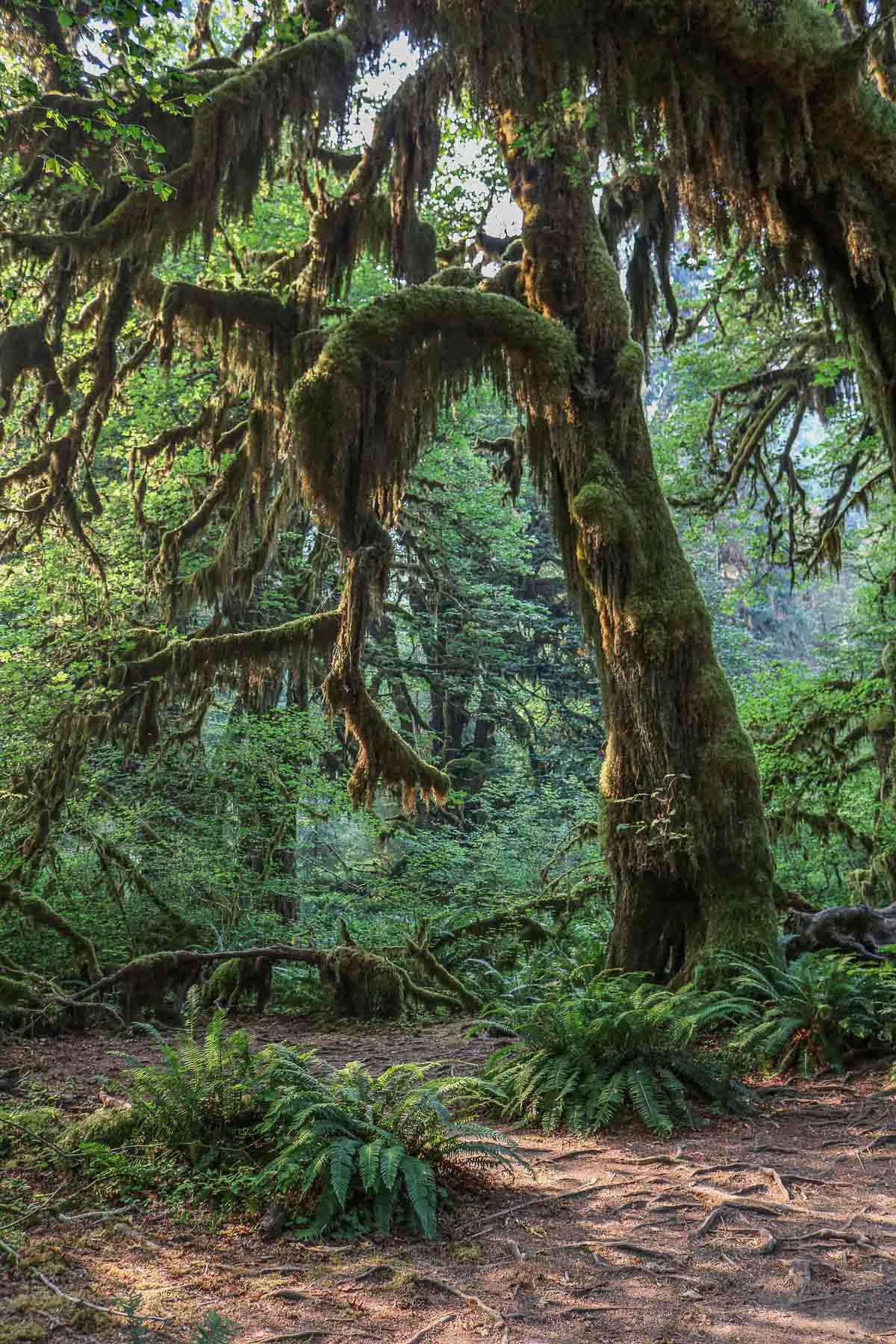
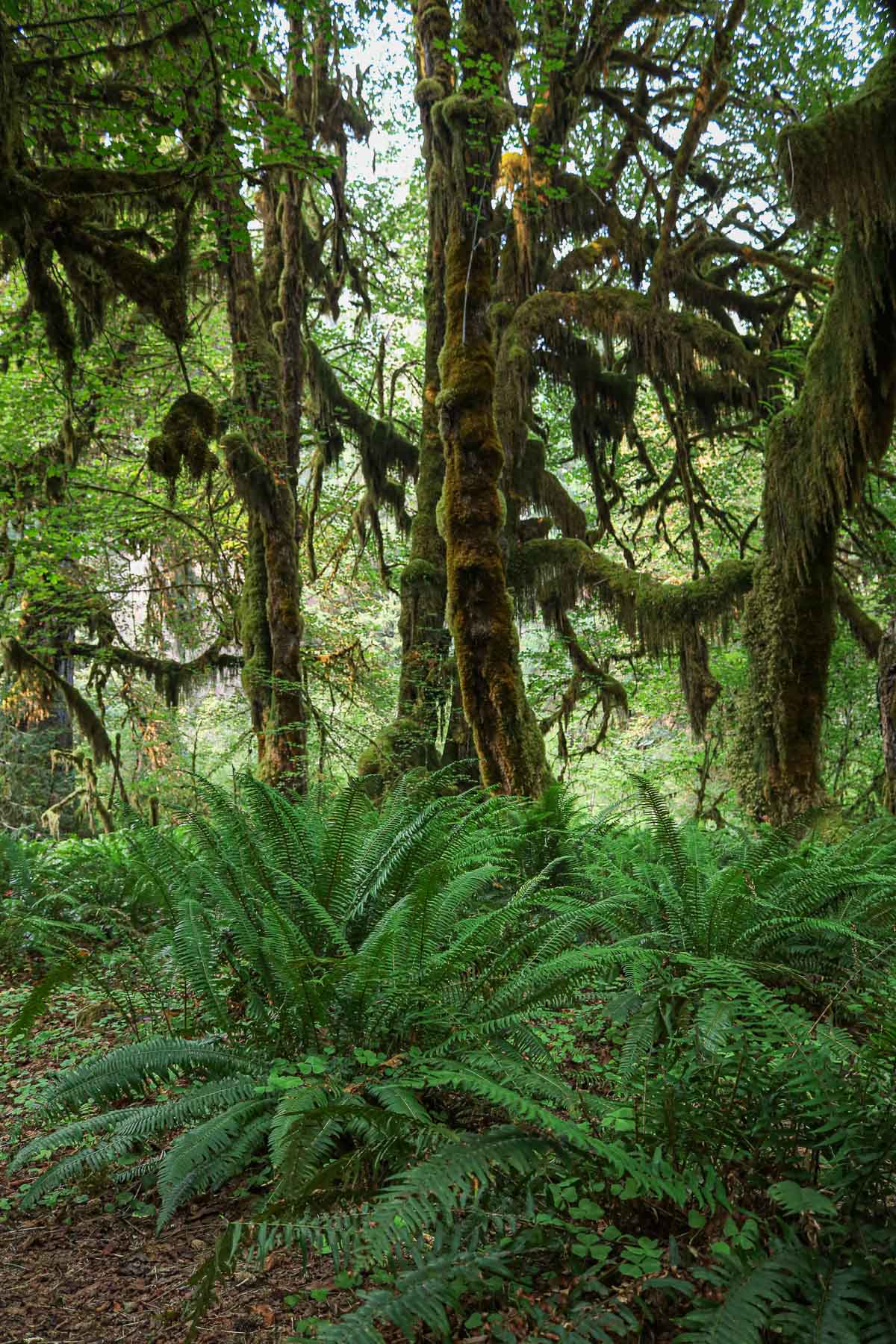
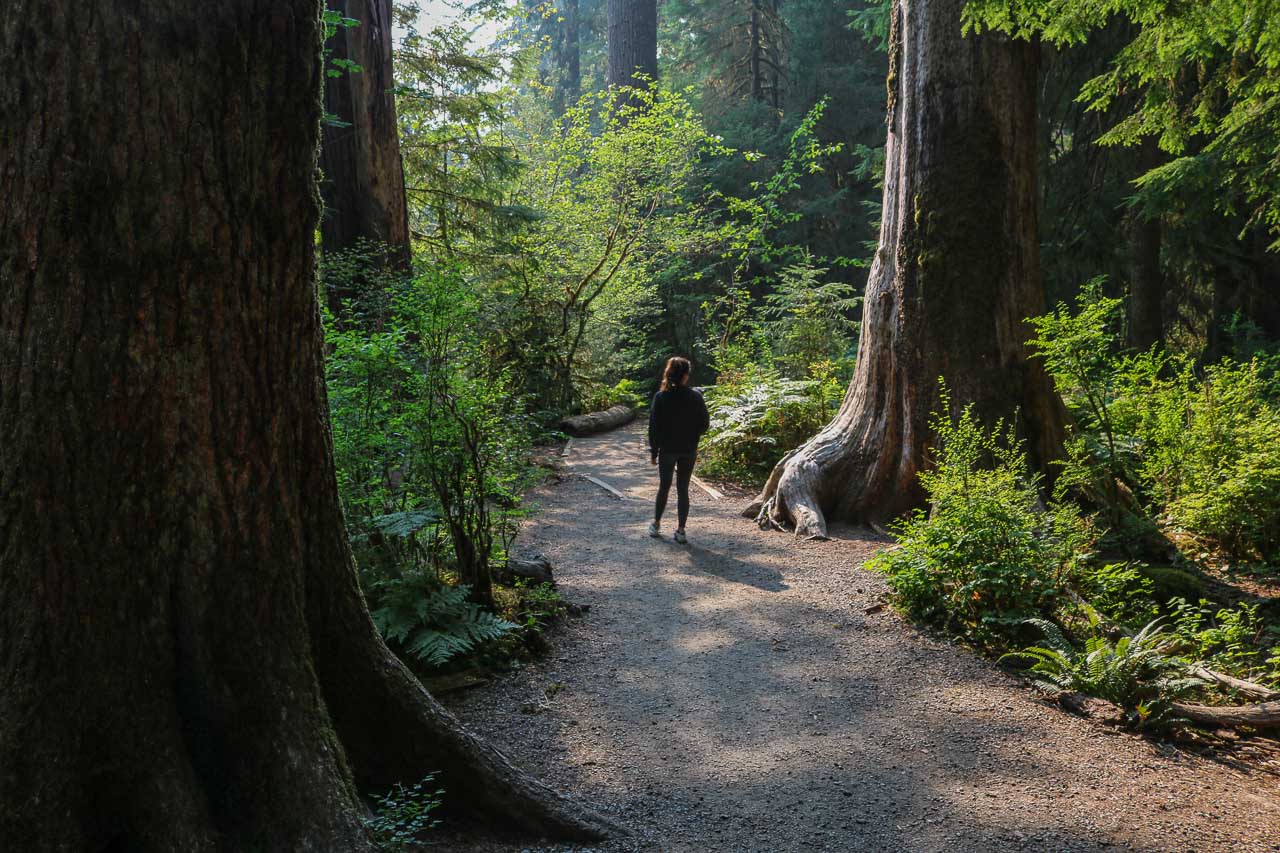
By far the most popular and well-known of the four rain forest in Olympic National Park, the Hoh Rain Forest is renowned for its mossy trees, lush scenery, and wonderful hiking.
This is, for example, the only rain forest in the park that has its own visitor center. The Hoh Rain Forest Visitor Center has everything from exhibits and visitor information to a bookstore and passport stamping station. Food or gas are not available, however.
From the visitor center, you can access two short but incredibly scenic self-guided trails:
- The Spruce Nature Trail is a 1.2-mile loop through old- and new-growth forest alongside Taft Creek and the Hoh River.
- The Hall of Mosses Trail is a 0.8-mile loop through gorgeous old-growth forest, including a famous grove of club moss-draped maple trees. In my opinion, this is easily one of the best short hikes in the entire National Park System.
Additionally, the Hoh River Trail also starts near the visitor center, an 18.5-mile one-way trail that parallels the Hoh River all the way up to the Blue Moraine on the north flank of Mount Olympus. You can hike this trail as far as you please.
If you’d like to hike the Hoh River Trail, which is also known for its excellent elk viewing opportunities, as a day hike, there are a few popular turn-around points:
- First River access: 1.8 miles roundtrip
- Mineral Creek Falls: 5.4 miles roundtrip
- Cedar Grove: 8 miles roundtrip
As you walk beneath the towering evergreens and moss-draped maples, make sure to look around you for wildlife. Elk are often seen in these forests, while on the ground, you may spot banana slugs, salamanders, snails, and various rodents.
Up in the trees, look for birds like barred bowls, northern spotted owls, Canada grey jays, and American robins. River otters frolic in streams, while black bears and bobcats roam the undergrowth.
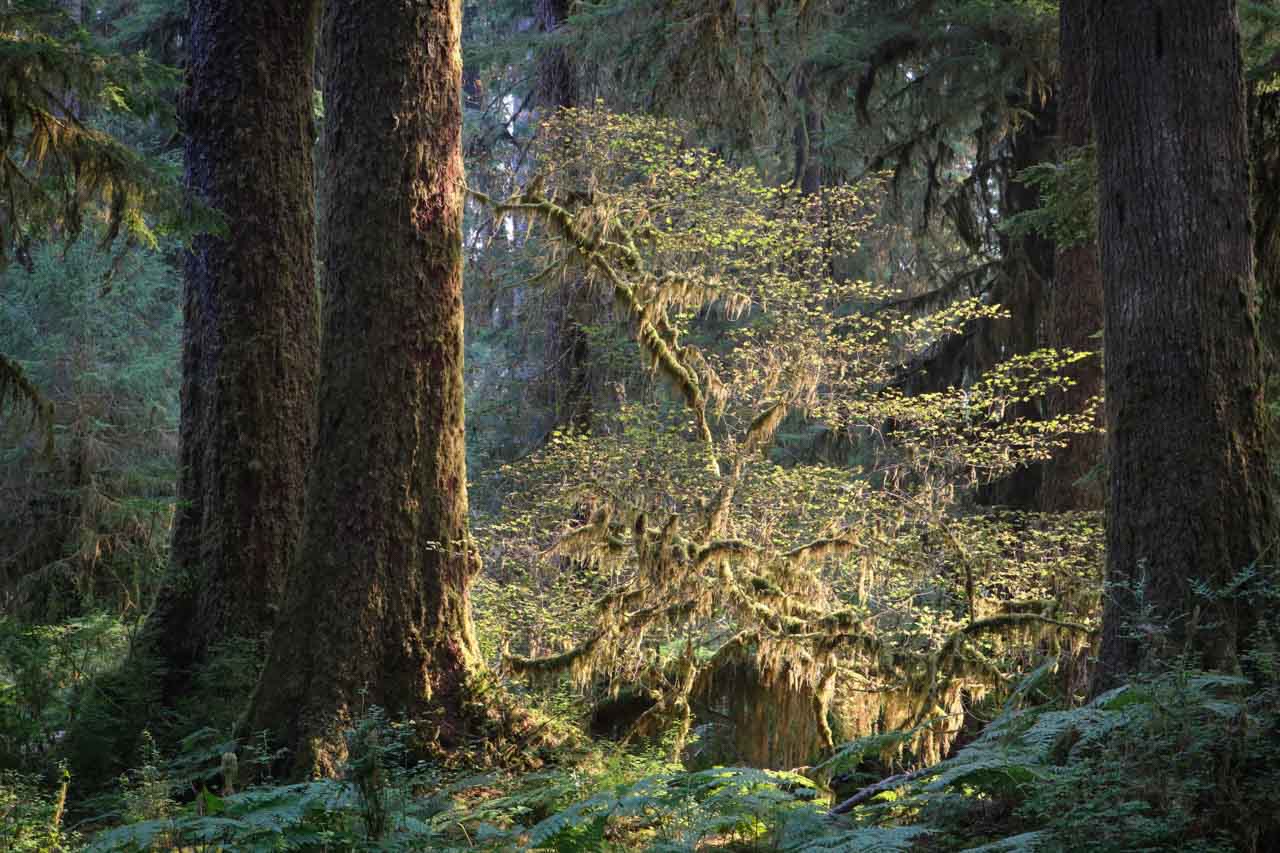
As far as places to stay in the Hoh Rain Forest go, it doesn’t have much to offer besides a 72-site campground, the setting of which is—it must be said—absolutely stunning. You can, and probably should, reserve campsites in advance on Recreation.gov.
If you’d like a roof over your head, the nearest options are in Forks (31 miles) or Kalaloch (39 miles).
To people who are visiting the Olympic National Park rain forests for the first time, I’d strongly recommend focusing on the Hoh Rain Forest first. It’s jaw-droppingly beautiful and it does live up to all the photos you might see on social media.
You can find more information about the Hoh Rain Forest in Olympic National Park on the park’s website.
4. Bogachiel Rain Forest
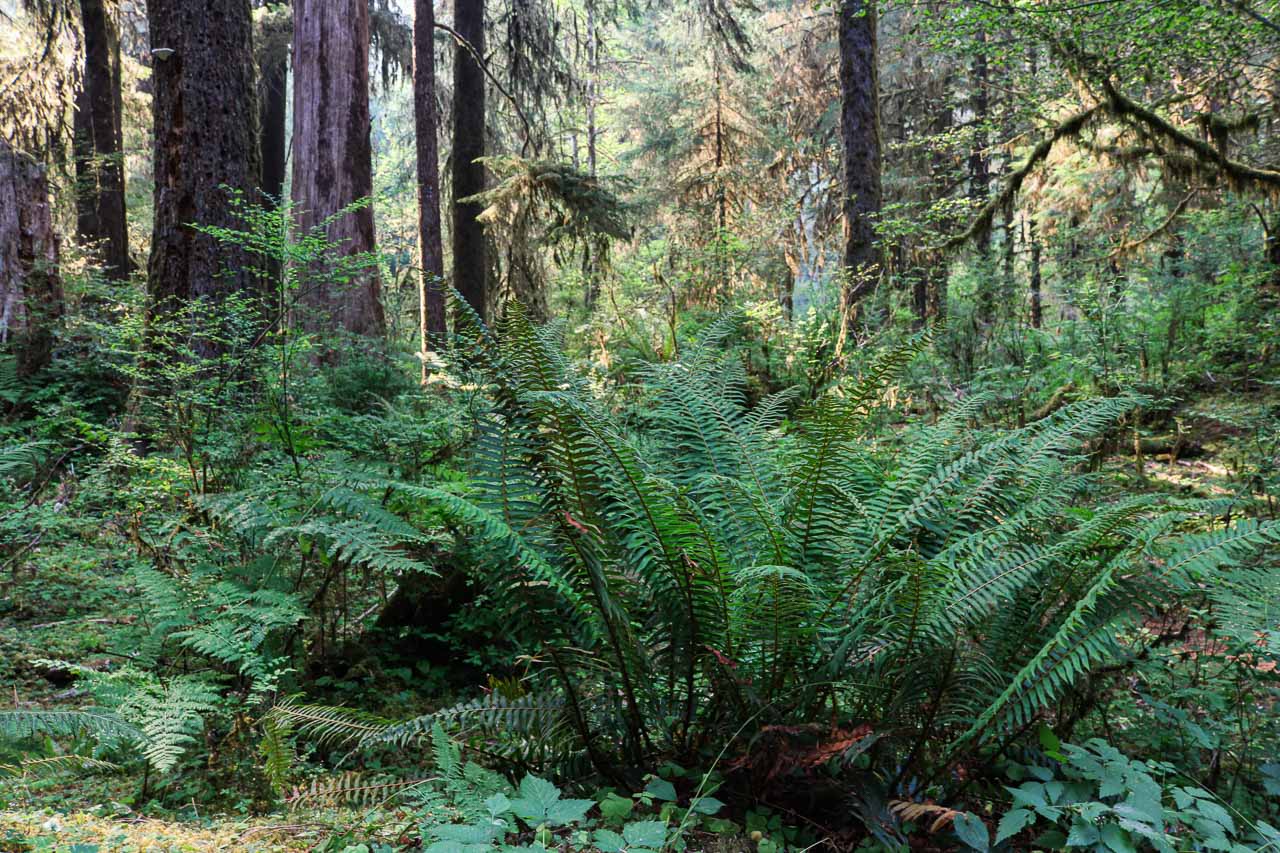
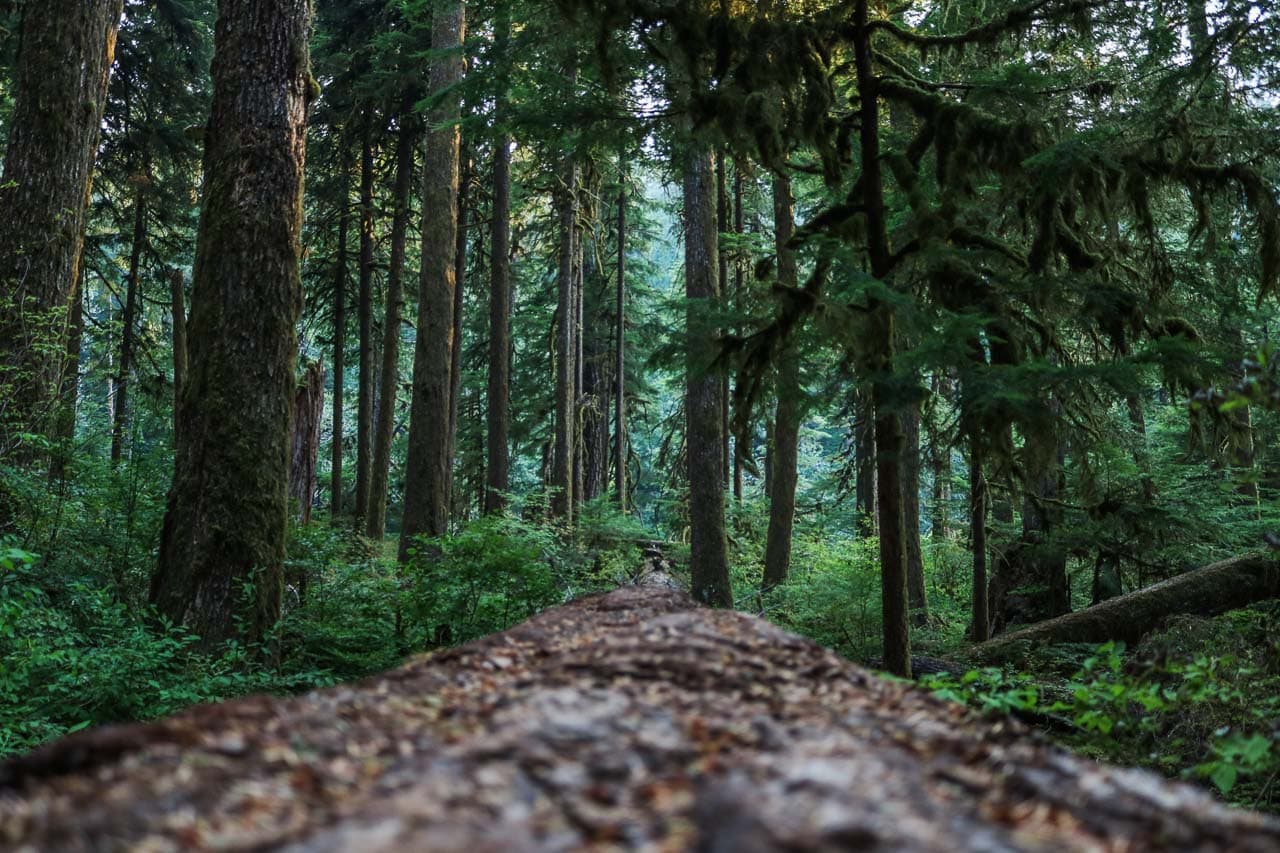
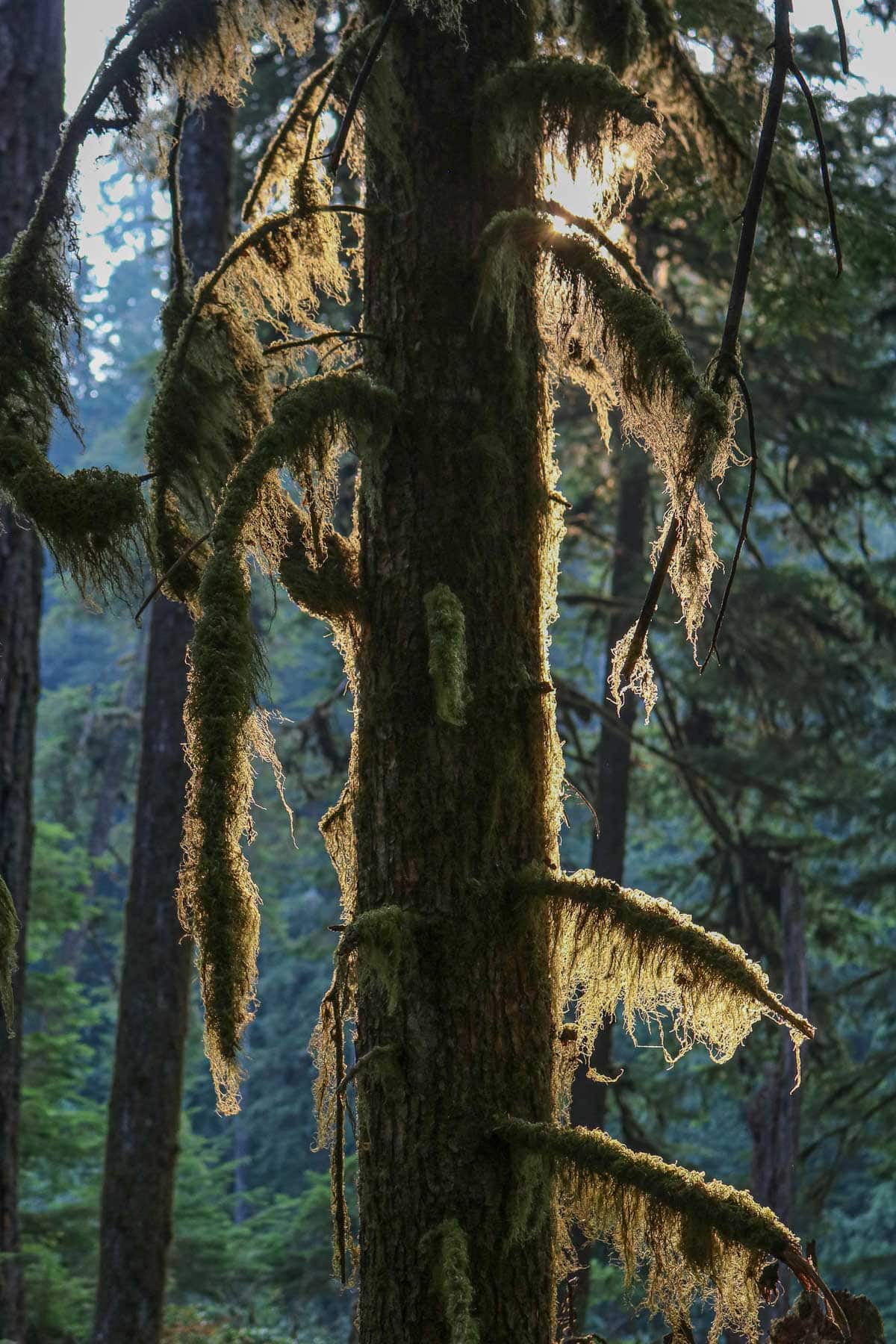
The least-known and least-visited rain forest in Olympic National Park, the Bogachiel Rain Forest is accessible only on foot.
You can get there via the Bogachiel Rain Forest River Trail in Olympic National Forest, which enters Olympic National Park after 1.5 miles. It then becomes the Bogachiel River Trail, which is a rather difficult trail that involves creek crossings. Its upper sections may even require map and compass skills to follow.
For a short and easier hike (in the national forest), you can combine the Bogachiel Rain Forest River Trail and Ira Spring Wetland Trail to create a great loop hike.
In terms of natural beauty, the Bogachiel Rain Forest really holds its own against more popular and famous forests like the Quinault or Hoh.
Here, you’ll also find moss-draped maples, sprawling collection of ferns, huge old-growth evergreens, low-elevation wetlands and scenic streams, as well as wildlife viewing opportunities.
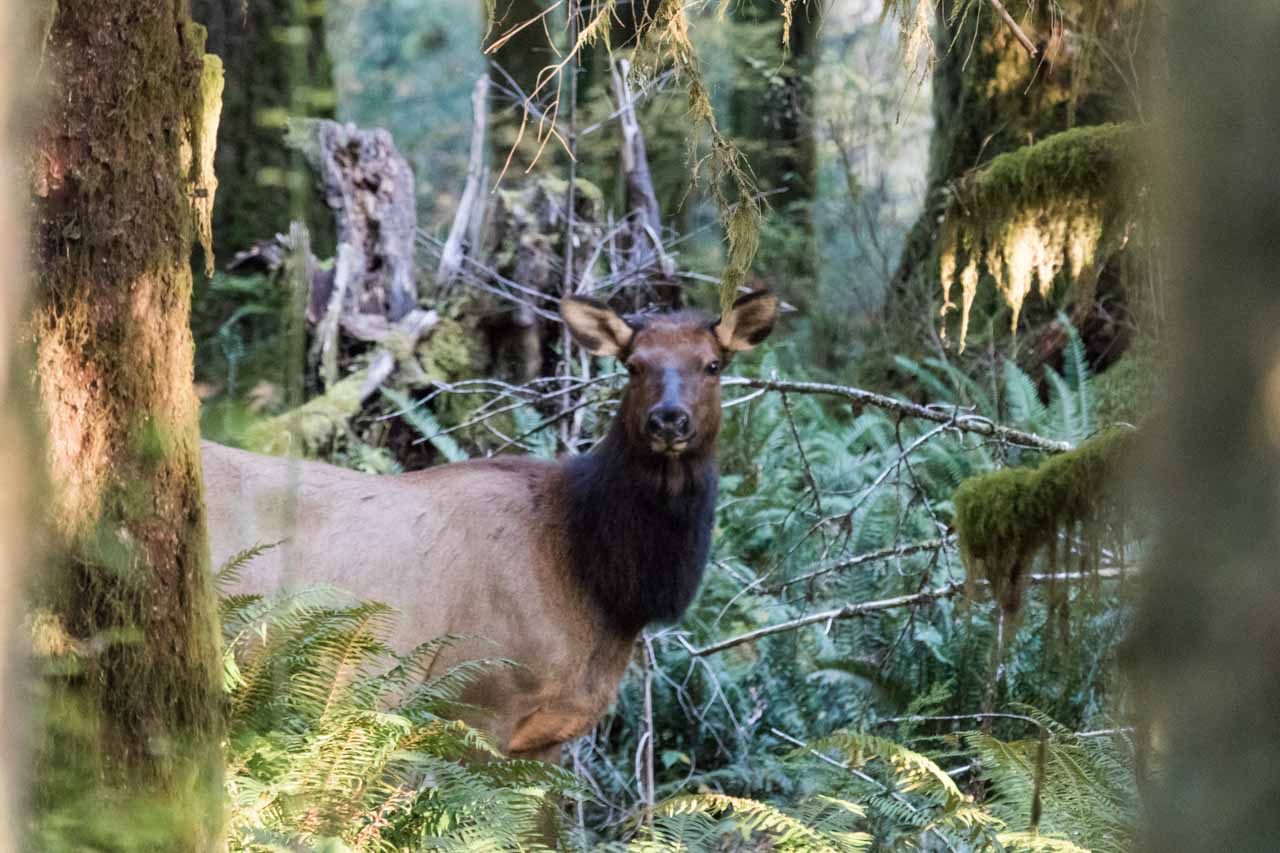
Wildlife Safety in the Olympic National Park Rain Forests
The park warns visitors that “all park wildlife are potentially dangerous to humans and can sometimes be unpredictable.” That said, there are three large mammal species that require special attention:
- Roosevelt elk – large numbers of elk live in the Olympic rain forests; they can be especially aggressive during the spring calving season and fall mating season. Learn how to act when encountering elk here.
- Black bears – bear sightings are quite common in these rain forests; while negative encounters on trails are rare, they are not impossible and hikers are advised to be vigilant and carry bear spray. Learn how to act when encountering a black bear here.
- Cougars – although mostly active at night, cougars (also known as pumas or mountain lions) are occasionally spotted by visitors throughout Olympic National Park, including in rain forests. Learn how to act when encountering a cougar here.
And FYI, there are no venomous snakes in Olympic National Park!
For more information about wildlife safety in Olympic National Park, I’d like to refer you to this page on the park’s website.






